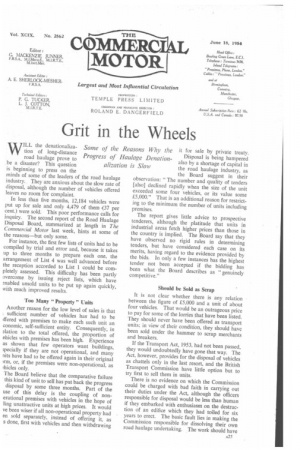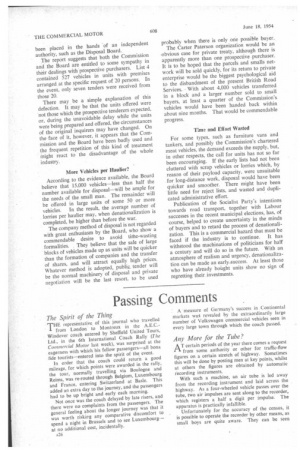Grit in the Wheels
Page 27

Page 28

If you've noticed an error in this article please click here to report it so we can fix it.
WILL the denationalization of long-distance road haulage prove to be a disaster? This question is beginning to press on the minds of some of the leaders of the road haulage industry. They are anxious about the slow rate of disposal, although the number of vehicles offered leaves no room for complaint.
In less than five months, 12,184 vehicles were put up for sale and only 4,479 of them (37 per cent.) were sold. This poor performance calls for inquiry. The second report of the Road Haulage Disposal Board, summarized at length in The Commercial Motor last week, hints at some of the reasons—but only some.
For instance, the first few lists of units had to be compiled by trial and error and, because it takes up to three months to prepare each one, the arrangement of List 4 was well advanced before the reception accorded to List 1 could be completely assessed. This difficulty has been partly overcome by issuing reject lists, which have enabled unsold units to be put up again quickly, with much improved results.
Too Many " Property " Units Another reason for the low level of sales is that sufficient number of vehicles has had to be ■ ffered with premises to make each such unit an conomic, self-sufficient entity. Consequently, in elation to the total offered, the proportion of chides with premises has been high. Experience as shown that few operators want buildings, ipecially if they are not operational, and many nits have had to be offered again in their original )nn, or, if the premises were non-operational, as ihicles only.
The Board believe that the comparative failure this kind of unit to sell has put back the progress disposal by some three months. Part of the use of this delay is the coupling of nonerational premises with vehicles in the hope of ling unattractive units at high prices. It would ve been wiser if all non-operational property had en sold separately, instead of offering it, as s done, first with vehicles and then withdrawing it for sale by private treaty.
Disposal is being hampered also by a shortage of capital in the road haulage industry, as the Board suggest in their observation: "The number and quality of tenders [also] declined rapidly when the size of the unit exceeded some four vehicles, or its value some £5,000." That is an additional reason for restricting to the minimum the number of units including premises.
The report gives little advice to prospective tenderers, although the platitude that units in industrial areas fetch higher prices than those in the country is implied. The Board say that they have observed no rigid rules in determining tenders, but have considered each case on its merits, having regard to the evidence provided by the bids. In only a few instances has the highest tender not been accepted if the bidding has been what the Board describes as "genuinely competitive."
Should be Sold as Scrap It is not clear whether there is any relation between the figure of £5,000 and a unit of about four vehicles. That would be an outrageous price to pay for some of the lorries that have been listed. They should never have been offered as transport units; in view of their condition, they should have been sold under the hammer to scrap merchants and breakers.
If the Transport Act, 1953, had not been passed, they would undoubtedly have gone that way. The Act, however, provides for the disposal of vehicles as chattels only in the last resort, and the British Transport Commission have little option but to try first to sell them in units.
There is no evidence on which the Commission could be charged with bad faith in carrying out their duties under the Act, although the officers responsible for disposal would be less than human if they embarked with enthusiasm on the destruction of an edifice which they had toiled for six years to erect. The basic fault lies in making the Commission responsible for dissolving their own road haulage undertaking. • The work should have been placed in the hands of an independent authority, such as the Disposal Board. The report suggests that both the Commission and the Board are entitled to some sympathy in their dealings with prospective purchasers. List 4 contained 527 vehicles in units with premises arranged at the specific request of 20 persons. In the event, only seven tenders were received from those 20.
There may be a simple explanation of this defection. It may be that the units offered were not those which the prospective tenderers expected, or, during the unavoidable delay while the units were being prepared and offered, the circumstances of the original inquirers may have changed. On the face of it, however, it appears that the Commission and the Board have been badly used and the frequent repetition of this kind of treatment Might react to the disadvantage of the whole industry.
More Vehicles per Haulier?
According to the evidence available, the Board believe that 15,000 vehicles—less than half the number available for disposal—will be ample for the needs of the small man. The remainder will be offered in large units of some 50 or more vehicles. In the result, the average number of lorries per haulier may, when denationalization is completed, be higher than before the war. The company method of disposal is not regarded with great enthusiasm by the Board, who show a commendable desire to avoid tithe-wasting formalities. They believe that the sale of large blocks of vehicles made up as units will be quicker than the formation of companies and the transfer of shares, and will attract equally high prices. Whatever method is adopted, public., tender will be the normal machinery of disposal and private negotiation will be the last resort, to be used probably when there is only one possible buyer.
The Carter Paterson organization would be an obvious case for private treaty, although there is apparently more than one prospective purchaser. It is to be hoped that the parcels and smalls network will be sold quickly, for its return to private enterprise would be the biggest psychological aid to the disbandment of the present British Road Services. With about 4,000 vehicles transferred in a block and a larger number sold to small buyers, at least a quarter of the Commission's vehicles would have been handed back within about nine months. That would be commendable progress.
Time and Effort Wasted For some types, such as furniture vans and tankers, and possibly the Commission's chartered meat vehicles, the demand exceeds the supply, but, in other respects, the call for units has not so far been encouraging. If the early lists had not been cluttered with scrap vehicles or lorries which, by reason of their payload capacity, were unsuitable for long-distance work, disposal would have been quicker and smoother. There might have been little need for reject lists, and wasted and duplicated administrative effort.
Publication of the Socialist Party's intentions towards road transport, together with Labour successes in the recent municipal elections, has, of course, helped to create uncertainty in the minds of buyers and to retard the process of denationalization. This is a commercial hazard that must be faced if the industry is to continue. It has withstood the machinations of politicians for half a century and will do so in the future. With an atmosphere of realism and urgency, denationalization can be made an early-success. At least those who have already boiight units show no sign of regretting their. investments.




























































































